-
KanBo Installation
- KanBo Installation on Office 365 and Azure (Manual)
- KanBo Installation on Office 365 and Azure (KanBo Installer)
- KanBo On-Premises Installation Requirements and Prerequisites
- KanBo Installation On-Premise SharePoint 2013/2016/2019
- Creating and Updating the Elastic Cloud Deployment
- Creating a Linux Based Virtual Machine on Azure for Elastic Search
- Installing and Configuring Elastic Search on Debian
- Creating a Windows Virtual Machine on Azure for Elastic Search
- Installing and Configuring Elastic Search on Windows
- How to Create a X.509 High-Trust Certificate
- KanBo Setup
- KanBo Modern Webpart Installation
- Uninstall KanBo from Office 365
- Supported Browsers
-
KanBo Updates
-
Additional Components
- Setting Up KanBo Email Notifications on Azure
- Setting Up KanBo Email Notifications (On-Premise)
- KanBo Outlook Add-in Installation (O365 & On-Premise)
- Send Email to KanBo - Installation (Cloud)
- Send Email to KanBo - Installation (On-Premise)
- Enabling Email a Card Message
- KanBo and Microsoft Power Automate integration: Installation
- KanBo and Microsoft Power Automate Integration: Activation
- Installation of KanBo MyBoard Synchronization with Outlook Calendar and Outlook Tasks
- Installation of the Autodesk BIM Plugin for KanBo
- KanBo and UiPath Integration: Configuration
- Nintex Integration Installation
- KanBo API for Developers
- KanBo External User Groups (Active Directory Integration)
- KanBo Mini Application Installation
- Plugin for Adding Users to KanBo / Sharepoint When They First Enter it
- SharePoint Profiles Synchronization
- SharePoint Site Collection Balancing and Admin Warnings
- Sync Targets
- Installation of the KanBo Teams App
-
Tips & Tricks
- Configure How Documents Should Be Opened from KanBo
- Customize KanBo Background Images and KanBo Colors
- Define Board Features to Be Enabled or Disabled by Default
- Disable Sleeping Tabs in Browsers
- Disable/Enable Public Boards Creation
- Find Out the Certificate Expiration Dates On-Premise
- Get KanBo ID
- How to Change the Help URL in Your KanBo
- Import Users to KanBo
- Renew Certificate for KanBo Graph Installation
- Show KanBo Version
- Removing syncing of profile pictures in the Profile Sync job
-
Troubleshooting
Installation of KanBo MyBoard Synchronization with Outlook Calendar and Outlook Tasks
KanBo Exchange plugin will allow you to integrate all cards added to MyBoard into Outlook Tasks or Appointments. It works for both KanBo installation scenarios: Cloud and On Premise.
Now you can integrate all cards added to MyBoard as Outlook Tasks or Appontments in Outlook Calendar. You can also add new Appointments from Calendar to KanBo MyBoards as points on the Timeline.
Prerequisites:
- KanBo in version 2.7 or higher.
- Having Exchange administrator rights (both in Office 365 and On Premise scenarios),
- Having administrative rights over KanBo Azure Site (in cloud installation scenario) or KanBo IIS site (in Hybrid
or On Premise scenario), - Preparing an account which will have ApplicationImpersonation rights in Exchange. This account must have an
Exchange license. - Dowloading Exchange Integration plugin (KanBo.ExchangeCalendarPlugin.dll). Ask at support@kanboapp.com for the file.
Configuration
1. Make sure that all KanBo users who would like to use this functionality, have their emails added in their
profiles. To check it, enter KanBo Content Database in SQL Server Management Studio.
Expand the database folders, select Tables and then,dbo.UserProfiles. Right click on dbo.UserProfiles and choose
Select 1000 Top Rows. Now you can see which users have added their emails to profile and other information from
their profiles.
You can start editing the database to add emails to users if they’re empty (use option Edit Top 200 rows or use SQL
query). After changing the database content, please restart KanBo Web Site on Azure (Cloud installation) or KanBo
Site App Pool on IIs (On Premise)

2. You MUST maintain emails in users profiles manually (disable the option for users to modify this). Otherwise the user can set his email to other user's email and access other accounts.
- In Cloud scenario - Azure
1. Navigate to your Azure website folder via FTP or KUDU service (add .scm just before azurewebsites.net e.g https://kanbo-online.scm.azure..., then select Debug console -> PowerShell). Go the the wwwroot folder and select web.config. Start editing it.
2. Change the value from true to false and save the web.config.
<add key="KanBoUserCanEditProfile" value="false"></add>
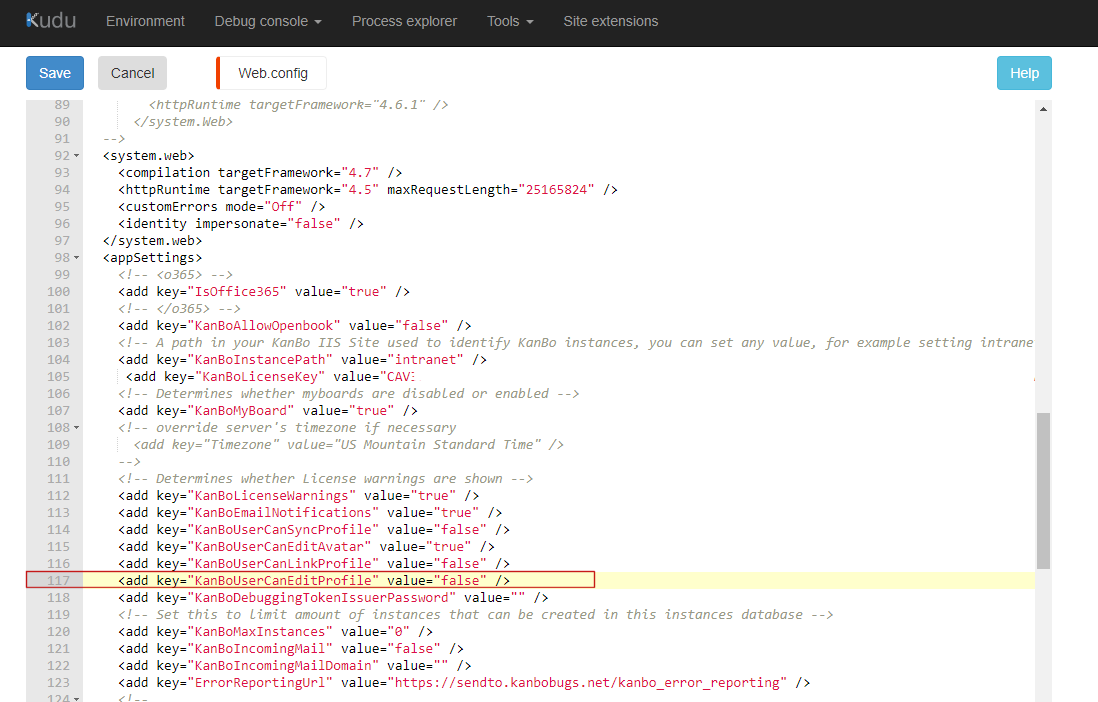
- On Premise and Hybrid scenario
1. Navigate to IIS on your server. Select the KanBo site and select Explore. Now you have entered KanBo website package. Click on web.config and start editing it.
2. Change the value from true to false and save the web.config.
<add key="KanBoUserCanEditProfile" value="false"></add>
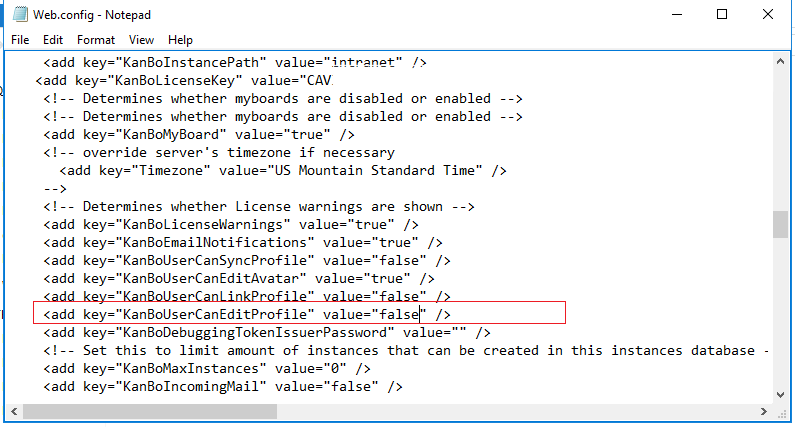
3. First, you must have a service account with permissions to access all mailboxes.
You can do this with the following snippet in Exchange Powershell.
- Cloud 1. Login into Powershell and apply the following command. 2. Change admin@KanBoTest.onmicrosoft.com to your user's login which will be ApplicationImpresonation administrator.
New-ManagementRoleAssignment -Name kanbo_exchange_impersonator -Role ApplicationImpersonation -User "admin@KanBoTest.onmicrosoft.com".
- On-premise 1. Follow this guide.
2. The Powershell command will be:
New-ManagementRoleAssignment -name:impersonationAssignmentName -Role:ApplicationImpersonation -User:serviceAccount
5. Make sure you have the ExchangeCalendarPlugin in your KanBo package
- In Cloud scenario - Azure 1. Navigate to your Azure website folder via FTP or KUDU service,then select Debug console -> PowerShell. Then select Site folder -> wwwroot.
2. Go to the Extensions folder and see if the KanBo.ExchangeCalendarPlugin.dll is here.

- On Premise and Hybrid scenario 1. Navigate to IIS on your server. Select the KanBo site and select Explore. Now you have entered KanBo website package.
2. Go to the Extensions folder and see if the KanBo.ExchangeCalendarPlugin.dll is here.
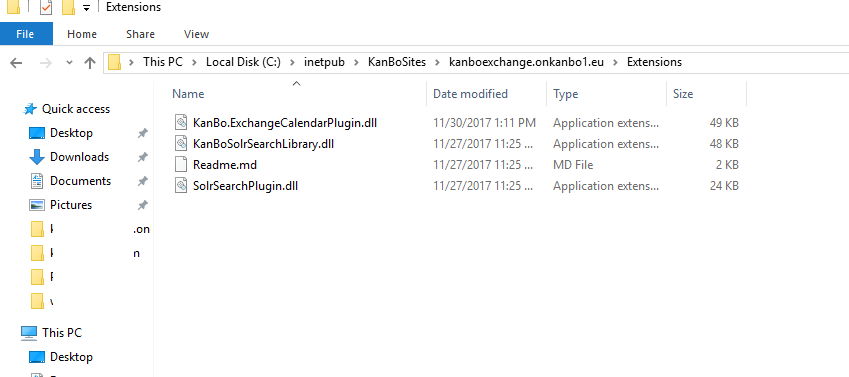
6. Adding a plugin line in your web.config
- In Cloud scenario - Azure 1. Navigate to your Azure website folder via FTP or KUDU service, then select Debug console -> PowerShell. Go the the wwwroot folder and select web.config. Start editing it.
2. Add the following value in <plugins> section. Make sure to change your userlogin, domain and password information to the user which you made administrator.
<plugin alias="calendar-source.exchange" login="{userlogin}@{domain}" password="{password}" endpoint="https://outlook.office365.com/EWS/Exchange.asmx"></plugin>

- On Premise and Hybrid scenario 1. Navigate to IIS on your server. Select the KanBo site and select Explore. Now you have entered KanBo website package. Click on web.config and start editing it.
2. Additionally, you might want to consider providing exchange endpoint parameter, which should look like this:
<plugin alias="calendar-source.exchange" login="exchangeimpersonator@developer.local" password="MyPassword" endpoint="https://exchange.example.org/EWS/Exchange.asmx" />

Additional security concerns
In case you need your login and password secured, you might want to use
machine key for data encryption. To
encrypt the data, you will need to follow these steps:
1. Go to the App pool of your KanBo Site. Select Advanced Settings and set Load User Profile as True,
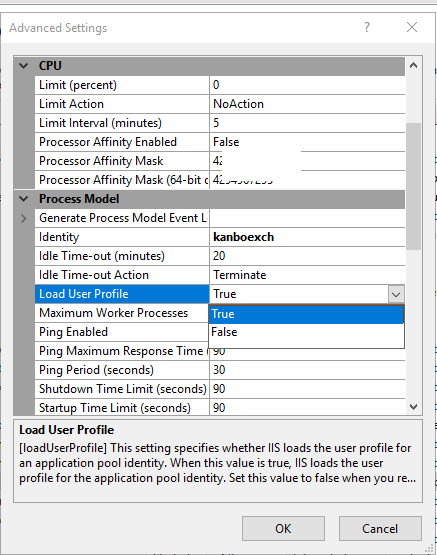
2. Add a plugin for data encryption into your web.config. You can do it both on Azure (when your KanBo is installed
in Cloud scenario ) and on KanBo package installed on IIs.
<plugin alias="exchange.data-protector-helper" />

3. The tool will be accessible on the hosted site (change kanbo.example.org to the used domain). Use your credentials and click submit.
https://kanbo.example.org/plugins/exchange-helper

4. Click on get encrypted data button and get your results.

5. Insert the secure data instead of login/password into your section of plugin in the web.config.
<plugin
alias="calendar-source.exchange"
secure-data="{your secure data in base64 string with no line breaks}"
endpoint="https://outlook.office365.com/..." />
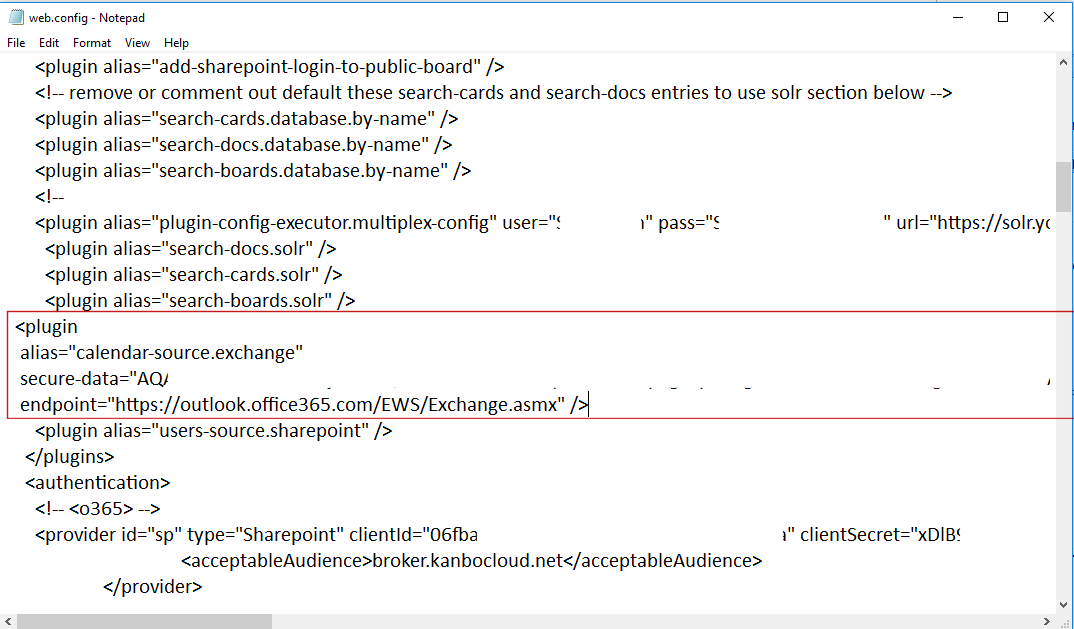
5. After generating encrypted data with the tool, you should disable it.
Was this article helpful?
Please, contact us if you have any additional questions.
